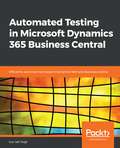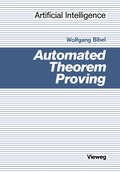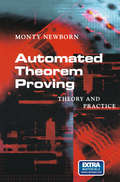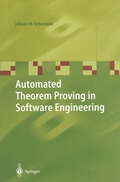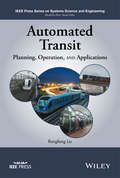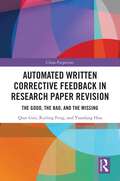- Table View
- List View
Automated Technology for Verification and Analysis: 10th International Symposium, ATVA 2012, Thiruvananthapuram, India, October 3-6, 2012, Proceedings (Lecture Notes in Computer Science #7561)
by Madhavan Mukund Supratik ChakrabortyThis book constitutes the thoroughly refereed proceedings of the 10th International Symposium on Automated Technology for Verification and Analysis, ATVA 2012, held at Thiruvananthapuram, Kerala, India, in October 2012. The 25 regular papers, 3 invited papers and 4 tool papers presented were carefully selected from numerous submissions. Conference papers are organized in 9 technical sessions, covering the topics of automata theory, logics and proofs, model checking, software verification, synthesis, verification and parallelism, probabilistic verification, constraint solving and applications, and probabilistic systems.
Automated Technology for Verification and Analysis: 5th International Symposium, ATVA 2007 Tokyo, Japan, October 22-25, 2007 Proceedings (Lecture Notes in Computer Science #4762)
by Kedar Namjoshi Tomohiro Yoneda Teruo Higashino Yoshio OkamuraThis book constitutes the refereed proceedings of the 5th International Symposium on Automated Technology for Verification and Analysis, ATVA 2007. The 29 revised full papers presented together with seven short papers address theoretical methods to achieve correct software or hardware systems, including both functional and non functional aspects; as well as applications of theory in engineering methods and particular domains and handling of practical problems occurring in tools.
Automated Technology for Verification and Analysis: Third International Symposium, ATVA 2005, Taipei, Taiwan, October 4-7, 2005, Proceedings (Lecture Notes in Computer Science #3707)
by Doron A. Peled Yih-Kuen TsayThe Automated Technology for Veri?cation and Analysis (ATVA) international symposium series was initiated in 2003, responding to a growing interest in formal veri?cation spurred by the booming IT industry, particularly hardware design and manufacturing in East Asia. Its purpose is to promote research on automated veri?cation and analysis in the region by providing a forum for int- action between the regional and the international research/industrial commu- ties of the ?eld. ATVA 2005, the third of the ATVA series, was held in Taipei, Taiwan, October 4–7, 2005. The main theme of the symposium encompasses - sign, complexities, tools, and applications of automated methods for veri?cation and analysis. The symposium was co-located and had a two-day overlap with FORTE 2005, which was held October 2–5, 2005. We received a total of 95 submissions from 17 countries. Each submission was assigned to three Program Committee members, who were helped by their subreviewers, for rigorous and fair evaluation. The ?nal deliberation by the P- gram Committee was conducted over email for a duration of about 10 days after nearly all review reports had been collected. In the end, 33 papers were - lectedforinclusionintheprogram.ATVA2005hadthreekeynotespeechesgiven respectively by Amir Pnueli (joint with FORTE 2005), Zohar Manna, and Wo- gang Thomas. The main symposium was preceded by a tutorial day, consisting of three two-hour lectures given also by the keynote speakers.
Automated Technology for Verification and Analysis: Second International Conference, ATVA 2004, Taipei, Taiwan, ROC, October 31 - November 3, 2004. Proceedings (Lecture Notes in Computer Science #3299)
by Farn WangAutomated Testing in Microsoft Dynamics 365 Business Central: Efficiently Automate Test Cases In Dynamics Nav And Business Central
by Luc Van VugtDynamics 365 Business Central is the new Cloud-based SaaS ERP proposition from Microsoft. It’s not as simple as it used to be way back when it was called Navigator, Navision Financials, or Microsoft Business Solutions-Navision. Our development practices are becoming more formal, and with this the call for test automation is pressing on us. This book will teach you to leverage testing tools available with Dynamics 365 Business Central to perform automated testing.
Automated Testing In Microsoft Dynamics 365 Business Central: Efficiently Automate Test Cases For Faster Development Cycles With Less Time Needed For Manual Testing
by Luc Van VugtEfficiently automate test cases for faster development cycles with less time needed for manual testing
Automated Theorem Proving (Künstliche Intelligenz)
by Wolfgang BibelSince both the coments and the structure of the book appeared to be successful, only minor changes were made. In particular, some recent work in ATP has been incorporated so that the book continues to reflect the state of the art in the field. The most significant change is in the quality of the layout including the removal of a number of inaccuracies and typing errors. R. Caferra, E. Eder, F. van der Linden, and J. Muller have caught vanous minor errors. P. Haddawy and S.T. Pope have provided many stilistic improvements of the English text. Last not least, A. Bentrup and W. Fischer have produced the beautiful layout. The extensive work of typesetting was financally supported within ESPRIT pro ject 415. Munchen, September 1986 W. Bibel PREFACE Among the dreams of mankind is the one dealing with the mechanization of human thought. As the world today has become so complex that humans apparently fail to manage it properly with their intellectual gifts, the realization of this dream might be regarded even as something like a necessity. On the other hand, the incredi ble advances in computer technology let it appear as a real possibility.
Automated Theorem Proving: Theory and Practice
by Monty NewbornThis text and software package introduces readers to automated theorem proving, while providing two approaches implemented as easy-to-use programs. These are semantic-tree theorem proving and resolution-refutation theorem proving. The early chapters introduce first-order predicate calculus, well-formed formulae, and their transformation to clauses. Then the author goes on to show how the two methods work and provides numerous examples for readers to try their hand at theorem-proving experiments. Each chapter comes with exercises designed to familiarise the readers with the ideas and with the software, and answers to many of the problems.
Automated Theorem Proving in Software Engineering
by Johann M. SchumannGrowing demands for the quality, safety, and security of software can only be satisfied by the rigorous application of formal methods during software design. This book methodically investigates the potential of first-order logic automated theorem provers for applications in software engineering. Illustrated by complete case studies on protocol verification, verification of security protocols, and logic-based software reuse, this book provides techniques for assessing the prover's capabilities and for selecting and developing an appropriate interface architecture.
Automated Theorem Proving: A Logical Basis (Fundamental Studies in Computer Science #1)
by D.W. LovelandAutomated Theorem Proving: A Logical Basis
Automated Theory Formation in Pure Mathematics (Distinguished Dissertations)
by Simon ColtonIn recent years, Artificial Intelligence researchers have largely focused their efforts on solving specific problems, with less emphasis on 'the big picture' - automating large scale tasks which require human-level intelligence to undertake. The subject of this book, automated theory formation in mathematics, is such a large scale task. Automated theory formation requires the invention of new concepts, the calculating of examples, the making of conjectures and the proving of theorems. This book, representing four years of PhD work by Dr. Simon Colton demonstrates how theory formation can be automated. Building on over 20 years of research into constructing an automated mathematician carried out in Professor Alan Bundy's mathematical reasoning group in Edinburgh, Dr. Colton has implemented the HR system as a solution to the problem of forming theories by computer. HR uses various pieces of mathematical software, including automated theorem provers, model generators and databases, to build a theory from the bare minimum of information - the axioms of a domain. The main application of this work has been mathematical discovery, and HR has had many successes. In particular, it has invented 20 new types of number of sufficient interest to be accepted into the Encyclopaedia of Integer Sequences, a repository of over 60,000 sequences contributed by many (human) mathematicians.
Automated Trading with R: Quantitative Research and Platform Development
by Chris ConlanLearn to trade algorithmically with your existing brokerage, from data management, to strategy optimization, to order execution, using free and publicly available data. Connect to your brokerage’s API, and the source code is plug-and-play.Automated Trading with R explains automated trading, starting with its mathematics and moving to its computation and execution. You will gain a unique insight into the mechanics and computational considerations taken in building a back-tester, strategy optimizer, and fully functional trading platform.The platform built in this book can serve as a complete replacement for commercially available platforms used by retail traders and small funds. Software components are strictly decoupled and easily scalable, providing opportunity to substitute any data source, trading algorithm, or brokerage. This book will:Provide a flexible alternative to common strategy automation frameworks, like Tradestation, Metatrader, and CQG, to small funds and retail tradersOffer an understanding of the internal mechanisms of an automated trading systemStandardize discussion and notation of real-world strategy optimization problemsWhat You Will LearnUnderstand machine-learning criteria for statistical validity in the context of time-seriesOptimize strategies, generate real-time trading decisions, and minimize computation time while programming an automated strategy in R and using its package libraryBest simulate strategy performance in its specific use case to derive accurate performance estimatesUnderstand critical real-world variables pertaining to portfolio management and performance assessment, including latency, drawdowns, varying trade size, portfolio growth, and penalization of unused capitalWho This Book Is ForTraders/practitioners at the retail or small fund level with at least an undergraduate background in finance or computer science; graduate level finance or data science students
Automated Transit: Planning, Operation, and Applications (IEEE Press Series on Systems Science and Engineering)
by Rongfang LiuA comprehensive discussion of automated transit This book analyzes the successful implementations of automated transit in various international locations, such as Paris, Toronto, London, and Kuala Lumpur, and investigates the apparent lack of automated transit applications in the urban environment in the United States. The book begins with a brief definition of automated transit and its historical development. After a thorough description of the technical specifications, the author highlights a few applications from each sub-group of the automated transit spectrum. International case studies display various technologies and their applications, and identify vital factors that affect each system and performance evaluations of existing applications. The book then discusses the planning and operation of automated transit applications at both macro and micro levels. Finally, the book covers a number of less successful concepts, as well as the lessons learned, allowing readers to gain a comprehensive understanding of the topic. Key features: Provides a thorough examination of automated transit applications, their impact and implications for society Written by the committee chair for the Automated Transit Systems Transportation, Research Board Offers essential information on planning, costs, and applications of automated transit systems Covers driverless metros, automated LRT, group and personal rapid transit, a review of worldwide applications Includes capacity and safety guidelines, as well as vehicles, propulsion, and communication and control systems This book is essential reading for engineers, researchers, scientists, college or graduate students who work in transportation planning, engineering, operation and management fields.
Automated Transit: Planning, Operation, and Applications (IEEE Press Series on Systems Science and Engineering)
by Rongfang LiuA comprehensive discussion of automated transit This book analyzes the successful implementations of automated transit in various international locations, such as Paris, Toronto, London, and Kuala Lumpur, and investigates the apparent lack of automated transit applications in the urban environment in the United States. The book begins with a brief definition of automated transit and its historical development. After a thorough description of the technical specifications, the author highlights a few applications from each sub-group of the automated transit spectrum. International case studies display various technologies and their applications, and identify vital factors that affect each system and performance evaluations of existing applications. The book then discusses the planning and operation of automated transit applications at both macro and micro levels. Finally, the book covers a number of less successful concepts, as well as the lessons learned, allowing readers to gain a comprehensive understanding of the topic. Key features: Provides a thorough examination of automated transit applications, their impact and implications for society Written by the committee chair for the Automated Transit Systems Transportation, Research Board Offers essential information on planning, costs, and applications of automated transit systems Covers driverless metros, automated LRT, group and personal rapid transit, a review of worldwide applications Includes capacity and safety guidelines, as well as vehicles, propulsion, and communication and control systems This book is essential reading for engineers, researchers, scientists, college or graduate students who work in transportation planning, engineering, operation and management fields.
Automated Unit Testing with ABAP: A Practical Approach
by James E. McDonoughWrite automated unit tests for the ABAP language. This book teaches programmers using simple examples and metaphors and explains the underlying concepts of writing effective automated unit tests. Many, if not most, ABAP programmers learned their programming and testing skills before the ABAP development environment provided an automated unit testing facility. Automated Unit Testing with ABAP: A Practical Approach offers hope and salvation to ABAP programmers who continue to toil with antiquated manual unit testing processes, taking them by the hand and lifting them out of that dungeon of despair with a modern and proven alternative. It begins by explaining how the xUnit family of automated testing frameworks provides a quick and effective means of insuring high-quality software. It then focuses on the ABAP Unit Testing Facility, the xUnit framework applicable specifically to the ABAP language, showing how it can be used to bring ABAP applications under automated testing control, from old legacy applications to those newly written.Whereas xUnit testing has been widely accepted with developers writing in many other programming languages, it is an unfortunate fact in the ABAP community that many programmers still are unfamiliar with xUnit concepts and do not know how to begin implementing automated unit testing into their development process. This book demonstrates how to refactor programs so they become designed for testability, showing how to use process encapsulation and test isolation to facilitate automated testing, including a thorough explanation of test-driven development and the use of test doubles. The book: Shows how to write automated unit tests for ABAPInstills ABAP programmers with the confidence to refactor poorly written codeExplains how an automated testing harness facilitates rapid software developmentTeaches how to utilize test-driven development (TDD) with ABAPOffers advice and tips on the best ways to write automated unit tests What You Will Learn Become familiar with the xUnit approach to testingKnow the ABAP statements that interfere with running automated unit tests and how to accommodate themUnderstand what it means to isolate code for testing and how this is achievedGain the confidence to refactor poorly written codeMake ABAP programs designed for testabilityReap the benefits of spending less time manually unit testing ABAP programsUse test-driven development (TDD) with ABAP programmingUse configurable test doubles in ABAP Who This Book Is ForABAP programmers who remain unfamiliar with the automated unit testing facility and those who already use it but want to improve their skill writing and using automated tests. The book addresses the reluctance and trepidation felt by procedural ABAP programmers who need to know some object-oriented concepts to use this facility, expands their horizons, and helps them step through the doorway leading to a different approach to program design.
Automated Validation & Verification of UML/OCL Models Using Satisfiability Solvers
by Nils Przigoda Robert Wille Judith Przigoda Rolf DrechslerThis book provides a comprehensive discussion of UML/OCL methods and design flow, for automatic validation and verification of hardware and software systems. While the presented flow focuses on using satisfiability solvers, the authors also describe how these methods can be used for any other automatic reasoning engine. Additionally, the design flow described is applied to a broad variety of validation and verification tasks. The authors also cover briefly how non-functional properties such as timing constraints can be handled with the described flow.
Automated Vehicles and MaaS: Removing the Barriers (Wiley - IEEE)
by Bob WilliamsAUTOMATED VEHICLES AND MaaS A topical overview of the issues facing automated driving systems and Mobility as a Service, identifies the obstacles to implementation and offers potential solutionsAdvances in cooperative and automated vehicle (CAV) technologies, cultural and socio-economic shifts, measures to combat climate change, social pressures to reduce road deaths and injuries, and changing attitudes toward self-driving cars, are creating new and exciting mobility scenarios worldwide. However, many obstacles remain and are compounded by the consequences of COVID-19. Mobility as a Service (MaaS) integrates various forms of public and private transport services into a single on-demand mobility service. Combining trains, cars, buses, bicycles, and other forms of transport, MaaS promises a convenient, cost-effective, and eco-friendly alternative to private automobiles.Automated Vehicles and MaaS: Removing the Barriers is an up-to-date overview of the contemporary challenges facing CAVs and MaaS. Written in a clear and accessible style, this timely volume summarizes recent research studies, describes the evolution of automated driving systems and MaaS, identifies the barriers to their widespread adoption, and proposes potential solutions to overcome and remove these barriers. The text focuses on the claims, realities, politics, new organizational roles, and implementation problems associated with CAVs and MaaS—providing industry professionals, policymakers, planners, administrators, and investors with a clear understanding of the issues facing the introduction of automated driving systems and MaaS. This important guide and reference:Provides an overview of recent progress, the current state of the art, and discussion of future objectivesPresents both technical background and general overview of automated driving systems and MaaSCovers political, commercial, and practical issues, as well as technical and research content, yet suitable for non-specialistsHelps readers make informed decisions and realistic estimates for implementing mobility solutions and new business models for transport servicesIncludes an extensive bibliography with direct links to in-depth technical engineering and research informationAutomated Vehicles and MaaS: Removing the Barriers is an essential resource for transport providers, vehicle manufacturers, urban and transport planners, students of transportation, vehicle technology, and urban planning, and transport policy and strategy managers, advisors, and reviewers.
Automated Vehicles and MaaS: Removing the Barriers (Wiley - IEEE)
by Bob WilliamsAUTOMATED VEHICLES AND MaaS A topical overview of the issues facing automated driving systems and Mobility as a Service, identifies the obstacles to implementation and offers potential solutionsAdvances in cooperative and automated vehicle (CAV) technologies, cultural and socio-economic shifts, measures to combat climate change, social pressures to reduce road deaths and injuries, and changing attitudes toward self-driving cars, are creating new and exciting mobility scenarios worldwide. However, many obstacles remain and are compounded by the consequences of COVID-19. Mobility as a Service (MaaS) integrates various forms of public and private transport services into a single on-demand mobility service. Combining trains, cars, buses, bicycles, and other forms of transport, MaaS promises a convenient, cost-effective, and eco-friendly alternative to private automobiles.Automated Vehicles and MaaS: Removing the Barriers is an up-to-date overview of the contemporary challenges facing CAVs and MaaS. Written in a clear and accessible style, this timely volume summarizes recent research studies, describes the evolution of automated driving systems and MaaS, identifies the barriers to their widespread adoption, and proposes potential solutions to overcome and remove these barriers. The text focuses on the claims, realities, politics, new organizational roles, and implementation problems associated with CAVs and MaaS—providing industry professionals, policymakers, planners, administrators, and investors with a clear understanding of the issues facing the introduction of automated driving systems and MaaS. This important guide and reference:Provides an overview of recent progress, the current state of the art, and discussion of future objectivesPresents both technical background and general overview of automated driving systems and MaaSCovers political, commercial, and practical issues, as well as technical and research content, yet suitable for non-specialistsHelps readers make informed decisions and realistic estimates for implementing mobility solutions and new business models for transport servicesIncludes an extensive bibliography with direct links to in-depth technical engineering and research informationAutomated Vehicles and MaaS: Removing the Barriers is an essential resource for transport providers, vehicle manufacturers, urban and transport planners, students of transportation, vehicle technology, and urban planning, and transport policy and strategy managers, advisors, and reviewers.
Automated Vehicles as a Game Changer for Sustainable Mobility: Learnings and Solutions (Contributions to Management Science)
by Danielle Attias Adrian Boos Dimitri Konstantas Guy FournierThis open access book explores a vision for a sustainable future in urban mobility through the AVENUE project, showcasing full-scale demonstrations of automated minibuses in European cities. AVENUE pioneers on-demand, door-to-door services, challenging traditional fixed bus itineraries. It delves into the implementation of automated vehicles, emphasizing safety, services, cybersecurity, and accessibility. Part two evaluates the economic, environmental, and social impacts on companies, citizens, and cities. By integrating automated vehicles into Mobility-as-a-Service and Intelligent Transport Systems, the book argues for the using of automated vehicles as game changer towards a transformative shift to sustainable, citizen-centric mobility. It advocates for efficiency, flexibility, and resilience of the transport system without imposing coercive transformation policies.
Automated Verification of Concurrent Search Structures (Synthesis Lectures on Computer Science)
by Krishna Siddharth Patel Nisarg Shasha Dennis Wies ThomasSearch structures support the fundamental data storage primitives on key-value pairs: insert a pair, delete by key, search by key, and update the value associated with a key. Concurrent search structures are parallel algorithms to speed access to search structures on multicore and distributed servers. These sophisticated algorithms perform fine-grained synchronization between threads, making them notoriously difficult to design correctly. Indeed, bugs have been found both in actual implementations and in the designs proposed by experts in peer-reviewed publications. The rapid development and deployment of these concurrent algorithms has resulted in a rift between the algorithms that can be verified by the state-of-the-art techniques and those being developed and used today. The goal of this book is to show how to bridge this gap in order to bring the certified safety of formal verification to high-performance concurrent search structures. Similar techniques and frameworks can be applied to concurrent graph and network algorithms beyond search structures.
Automated Web Site Evaluation: Researchers’ and Practioners’ Perspectives (Human–Computer Interaction Series #4)
by M.Y. IvoryAmong all information systems that are nowadays available, web sites are definitely the ones having the widest potential audience and the most significant impact on the everyday life of people. Web sites contribute largely to the information society: they provide visitors with a large array of services and information and allow them to perform various tasks without prior assumptions about their computer literacy. Web sites are assumed to be accessible and usable to the widest possible audience. Consequently, usability has been recognized as a critical success factor for web sites of every kind. Beyond this universal recognition, usability still remains a notion that is hard to grasp. Summative evaluation methods have been introduced to identify potential usability problems to assess the quality of web sites. However, summative evaluation remains limited in impact as it does not necessarily deliver constructive comments to web site designers and developers on how to solve the usability problems. Formative evaluation methods have been introduced to address this issue. Evaluation remains a process that is hard to drive and perform, while its potential impact is probably maximal for the benefit of the final user. This complexity is exacerbated when web sites are very large, potentially up to several hundreds of thousands of pages, thus leading to a situation where eval uating the web site is almost impossible to conduct manually. Therefore, many attempts have been made to support evaluation with: • Models that capture some characteristics of the web site of interest.
Automated Workflow Scheduling in Self-Adaptive Clouds: Concepts, Algorithms and Methods (Computer Communications and Networks)
by G. Kousalya P. Balakrishnan C. Pethuru RajThis timely text/reference presents a comprehensive review of the workflow scheduling algorithms and approaches that are rapidly becoming essential for a range of software applications, due to their ability to efficiently leverage diverse and distributed cloud resources. Particular emphasis is placed on how workflow-based automation in software-defined cloud centers and hybrid IT systems can significantly enhance resource utilization and optimize energy efficiency.Topics and features: describes dynamic workflow and task scheduling techniques that work across multiple (on-premise and off-premise) clouds; presents simulation-based case studies, and details of real-time test bed-based implementations; offers analyses and comparisons of a broad selection of static and dynamic workflow algorithms; examines the considerations for the main parameters in projects limited by budget and time constraints; covers workflow management systems, workflow modeling and simulation techniques, and machine learning approaches for predictive workflow analytics. This must-read work provides invaluable practical insights from three subject matter experts in the cloud paradigm, which will empower IT practitioners and industry professionals in their daily assignments. Researchers and students interested in next-generation software-defined cloud environments will also greatly benefit from the material in the book.
Automated Written Corrective Feedback in Research Paper Revision: The Good, The Bad, and The Missing (China Perspectives)
by Qian Guo Ruiling Feng Yuanfang HuaThis book studies the use of an automated writing evaluation (AWE) systems in research paper revision for publication purposes by Chinese doctoral students.Research writing skills are essential for achieving academic status, and AWE tools can be a great companion on the journey. However, AWE tools may provide a disservice if users do not stay alert to inaccurate feedback, inaccurate correction suggestions, and missed errors. The effects of accurate feedback on revision outcomes have been the focus of a number of AWE studies, but student engagement and revision results in cases of inaccurate feedback and missed errors have rarely been investigated. Such investigations can provide practical advice on using automated feedback in research writing. This book provides a comprehensive evaluation of AWE tools and profiles student engagement with tool use in cases of different qualities of feedback. It can empower novice scholars and improve the effectiveness of academic writing instructors. The findings can also inform AWE system developers about possible ways of system improvement for research paper writing.The book will be particularly useful to students and scholars of language and linguistic studies, education, and academic English writing.
Automated Written Corrective Feedback in Research Paper Revision: The Good, The Bad, and The Missing (China Perspectives)
by Qian Guo Ruiling Feng Yuanfang HuaThis book studies the use of an automated writing evaluation (AWE) systems in research paper revision for publication purposes by Chinese doctoral students.Research writing skills are essential for achieving academic status, and AWE tools can be a great companion on the journey. However, AWE tools may provide a disservice if users do not stay alert to inaccurate feedback, inaccurate correction suggestions, and missed errors. The effects of accurate feedback on revision outcomes have been the focus of a number of AWE studies, but student engagement and revision results in cases of inaccurate feedback and missed errors have rarely been investigated. Such investigations can provide practical advice on using automated feedback in research writing. This book provides a comprehensive evaluation of AWE tools and profiles student engagement with tool use in cases of different qualities of feedback. It can empower novice scholars and improve the effectiveness of academic writing instructors. The findings can also inform AWE system developers about possible ways of system improvement for research paper writing.The book will be particularly useful to students and scholars of language and linguistic studies, education, and academic English writing.




